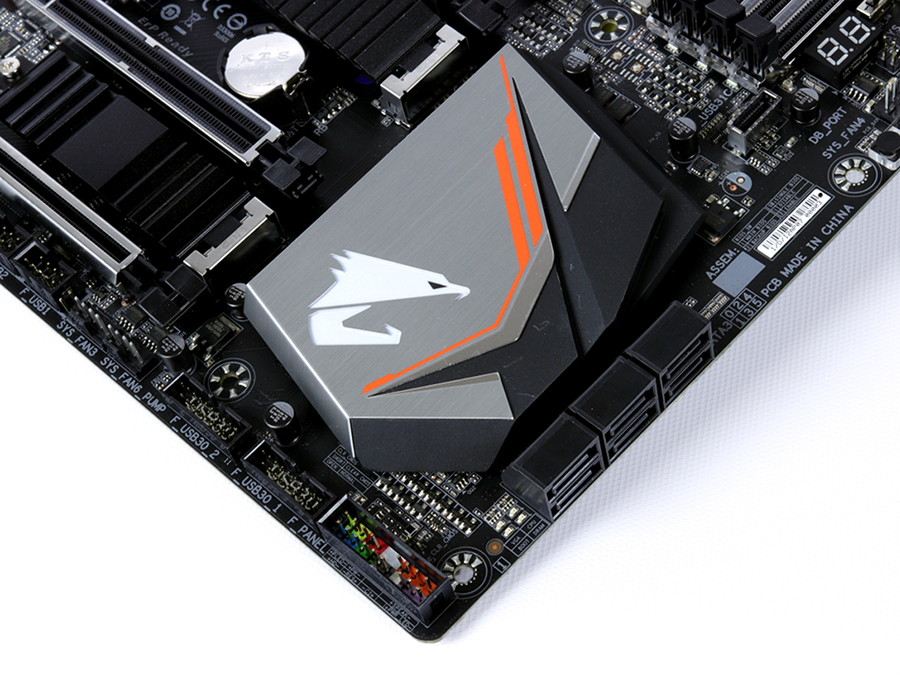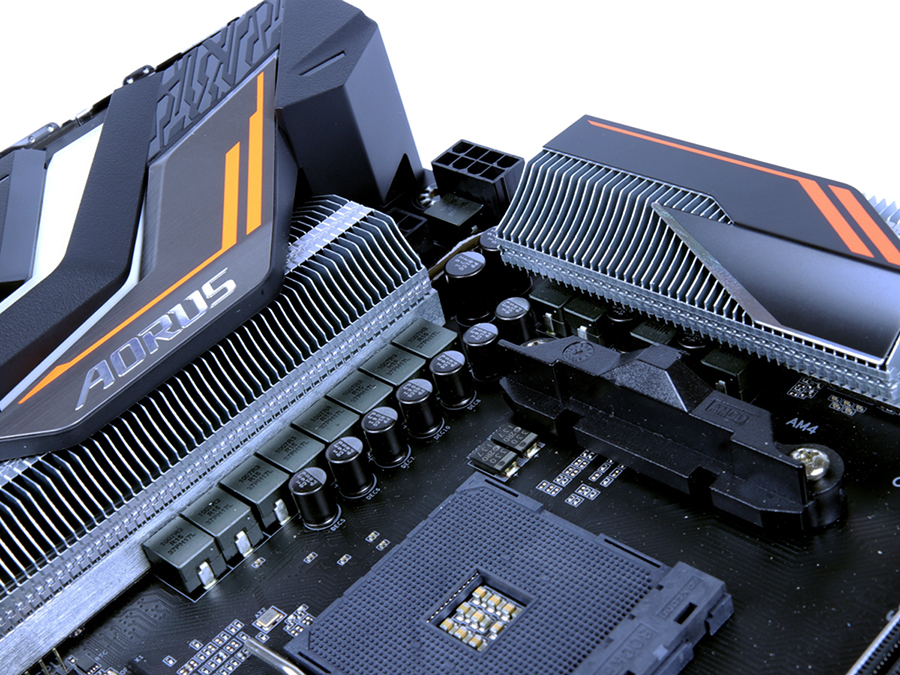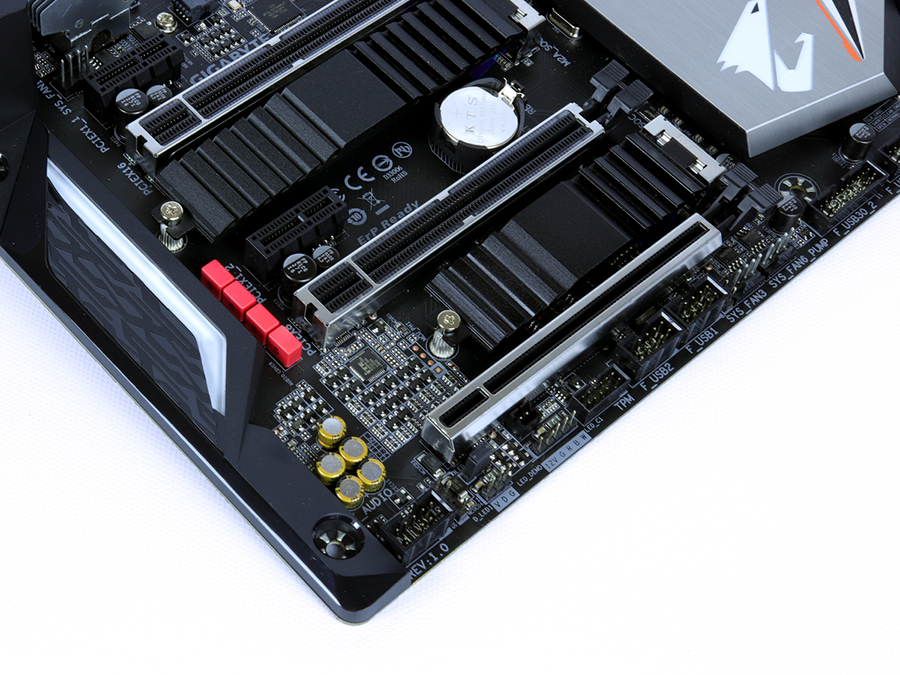Early Verdict
Gigabyte’s Aorus catches our mobo-jaded eye with its superb overclocking potential, excellent performance, and added lighting and options for a variety of builders.
Pros
- +
Regulator cooling and design
- +
Overclocking potential
- +
Excellent UEFI stability from day one
Cons
- -
Minor placement issues with board components
- -
Gen2 M.2
- -
Bland UEFI
Why you can trust Tom's Hardware
Features & Layout
We have been anticipating the next generation of AMD's Ryzen processors for a while now. Promises of improved IPC, better transistors, and increased performance all around have kept the buzz steady for several months. Even with Spectre and Meltdown plaguing processor architectures, 2nd Gen Ryzen has remained a potential bright spot for consumers, at a time when many other components are priced in the stratosphere.
And now that we have tested and reviewed the Ryzen 7 2700X, we can say definitively that AMD has delivered another impressive product that, at the very least, pushes right up close to Intel's competing silicon. What we haven’t heard so much about yet are the platforms that these new chips were designed to drop into. Today, we'll shine some light on the newest platform from AMD: the X470 chipset.
According to AMD, several thorns in the side the previous-generation 300 series chipsets are being rectified for this latest revision.The first notable feature is the tCTL (T Control) offset, which is an adjusted value of tDie (the true measure of the die temperature). The 2700X has a +10C offset, which AMD says ensures consistent fan policies on motherboards. More importantly, power delivery specifications are improved to help satisfy requirements for processor features such as AMD's improved Extended Frequency Range (XFR2), though many older X370 boards have already been deemed compliant with these requirements by AMD.
AMD is also increasing supported memory speeds, but only based on PCB layer count. Six layers or more will support up to DDR4-2933 speeds, while four layers support up to DDR4-2667 when using two single-rank DIMMs. This will be a critical factor for builders when debating between competing products and their intended memory configuration.
Another new feature bundled in with X470 is the StoreMI technology, which essentially enables multi-drive systems with both an SSD and a spinning hard drive the ability to “fuse” together and cache data on the SSD for improved performance. We covered this feature under its standalone product name--FuzeDrive--earlier this year.
The X470 is also backward-compatible with Ryzen 1000 series and other AM4-socket processors. Right out of the gate, if that shiny new 2700X is out of stock, builders can still plug in their previous-generation chip and be ready to game with minimal downtime. Conversely, users who own a 300-series motherboard can also install one of the new 2nd Gen Ryzen chips. Try doing anything like that with recent Intel-based hardware and you'll be in for some serious disappointment.
Aorus Gets a Facelift
Gigabyte has stepped up yet again to provide us with hardware for our early testing, and today we're looking specifically at the X470 Aorus Gaming 7 Wifi motherboard. Gigabyte's Aorus brand has become synonymous with RGB, and this board does not disappoint on the lighting front. However, Gigabyte’s designers have taken the feedback from the media and builders to make this board even better than their 300 series predecessors. This X470 board has toned down the plastic and over-aggressive molding of boards past, in favor of a more industrial and anodized styling. We'd call that an improvement.
Get Tom's Hardware's best news and in-depth reviews, straight to your inbox.
The contents of the board box are on par with other Aorus offerings for both Intel and AMD chips. For cables, you get four SATA, two thermistors, an RGB extension, and LED strip adapter. The WiFi implementation utilizes a standalone single antenna that can be routed away from the motherboard, enabling more positioning options. G-Connector, a 60mm single slot SLI bridge, and M.2 standoff screws complete the mechanical connection hardware. Gigabyte bundles in an Aorus badge, sticker sheet, documentation material, and driver disc, along with a VIP card. Sorry, Gigabyte, we're not posting that Members Only card on our Instagram feed.
On paper, X470 looks a whole lot like X370. The back panel on this board is similar to other Aorus boards and provides one Type-A and one Type-C USB 3.1 Gen2 port, coupled with six USB 3.1 Gen1 ports. Two additional USB 2.0 ports are available on the back panel for older peripherals. Owners of AMD's recent graphics-packing Raven Ridge chips like the Ryzen 5 2500G will need to look elsewhere, as this board lacks any video output. Two WiFi antenna ports are accessible here, as is an RJ-45 port for Gigabit Ethernet. Five analog audio jacks and a SPDIF connector hook up users to the Realtek ALC1220 codec, while pumping the signal back through the ESS SABRE digital-to-analog converter. Gigabyte tops it all off with an integrated backplate for additional structural support, as well as power and CMOS reset buttons easy access while building, upgrading, or troubleshooting.
We have been spoiled with the ample amount of PCIe slots on Threadripper boards, but X470 picks up where X370 left off on that front. The Gigabyte X470 Aorus Gaming 7 WiFi provides three PCIe x16 slots wired for 16, 8, and 4 lanes from top to bottom. The top two x16 slots support PCIe Gen3, but the bottom only complies with PCIe Gen2. Also, keep in mind that this bottom slot is disabled when using the bottom M.2 slot. For additional IO cards, two PCIe Gen2 x1 slots are located above the two Gen3 slots.


Storage options are above average for the X470 Aorus Gaming 7 WiFi, with 6 right-angled SATA3 connectors and access to two M.2 slots for smaller form-factor drives. The top M2A socket supports full PCIe Gen3 x4 NVMe and SATA3 drives, while the M2B slot provides PCIe Gen2 x4 and SATA3 support. Gigabyte’s marketing material touts the board’s ability to support M.2 RAID arrays, but given the PCIe disparity on this mainstream platform, we won’t be expecting RAID performance that's possible with the X399 platform. Regardless, both M.2 slots come paired with thermal pads and heat spreaders that can really be effective at keeping storage cool when sufficient airflow is present. Maybe this is a good opportunity to get a smaller M.2 SATA SSD for use with StoreMi!





The bottom edge hosts a plethora of headers for builders, with features such as front-panel audio, two RGB headers, trusted platform module (TPM), two USB2.0, two USB3.0, two 4-pin fans, and the usual front-panel headers. Rotating past the X470’s heatsink, a USB 3.1 Gen2 header is located just below the numeric debug LED. The four DDR4 DIMM slots support up to DDR4-3600 when overclocked, and come equipped with dual latches that give that satisfying ‘click’ when DIMMs are inserted. DualBIOS DIP switches are accessible to the right of the DIMMs and three additional 4-pin fan headers are located below the 24-pin ATX connector. In true Aorus fashion, an LED strip lines the far right of the board for customizable accent lighting.


The northern edge of the board allocates real estate to two additional RGB headers, the OC button, two more 4-pin fan headers, and both an 8-pin and 4-pin 12 volt ATX header. Let’s not forget about the LED header for AMD Wraith-style coolers and the last 4-pin fan header above the top PCIe x1 slot. In total, 8 hybrid fan headers are available here, which support 24-watt devices. Each fan can have programmable fan curves provided by the Smart Fan interface in the UEFI.


The Gigabyte X470 Aorus Gaming 7 WiFi provides a plethora of different RGB options. For starters, the board itself glows with lighting from the DIMM slots, X470 chipset, PCIe Gen3 x16 slots and IO shield areas. These lights are programmable through the RGB Fusion software for lighting various patterns and zones for a top-shelf out-of-the-box lighting experience. Does the computer need more of an aura? Users can install either 12V or 5V LED strips into the proper headers, for even more options for lighting their build.


Now, let’s talk about what makes this board unique. First, Gigabyte outfits its voltage regulators with a direct-attach heat pipe that routes into a proper fin stack array for increased surface area for cooling. This might seem purely an aesthetic feature, but this fin stack is phenomenal when compared to other implementations such as the MSI X370 Krait Gaming boards (which used essentially solid blocks of material). We’ll dive more into this feature’s performance in the overclocking section.
Next is the integrated backplate around the back IO. We like to hold premium boards like this by the top left section, due their heft. And this backplate helps there, feeling extremely solid, with no visible flex or bending. Another interesting feature nearly escaped this reviewer’s eyes: There are voltage sense points directly above the DIMMs labeled COUPON1, 2, 3, and 4. This is imperative for competitive overclockers when software-based sensors are not accurate, or don't report the right voltages needed to hit that aspirational 5GHz mark.
We have very few issues with this board overall. Our primary complaints are focused around shifting components around the X or Y axis for improved ergonomics. Perhaps removing the 2nd M.2 slot in favor of additional SATA3 ports would better suit more builders, as the Gen2 M.2 is under-utilizing the interface. Otherwise, the layout and design of this board are stellar, and the inclusion of the fin stack, voltage sense points, and DualBIOS capability make the X470 Aorus Gaming 7 WiFi a great choice for overclockers.
MORE: Best Motherboards
MORE: How To Choose A Motherboard
MORE: All Motherboard Content





